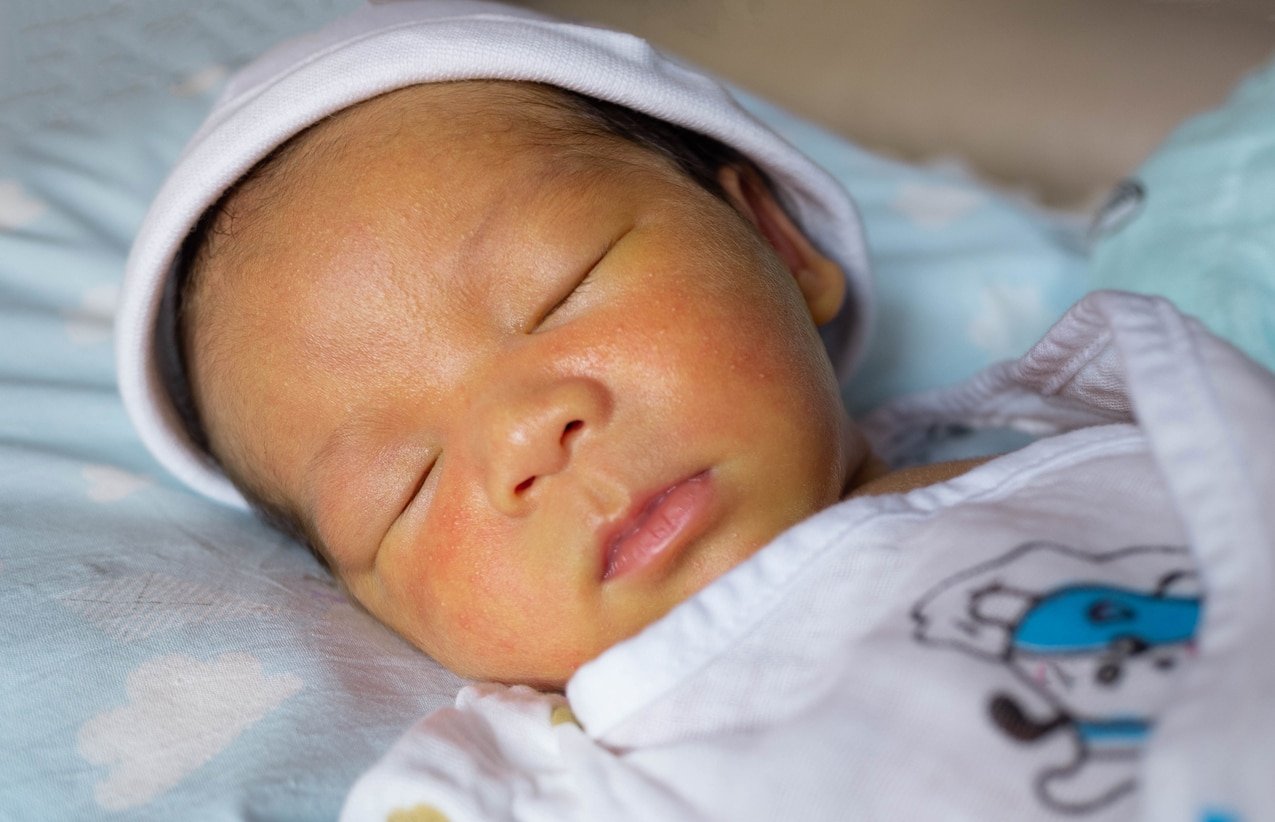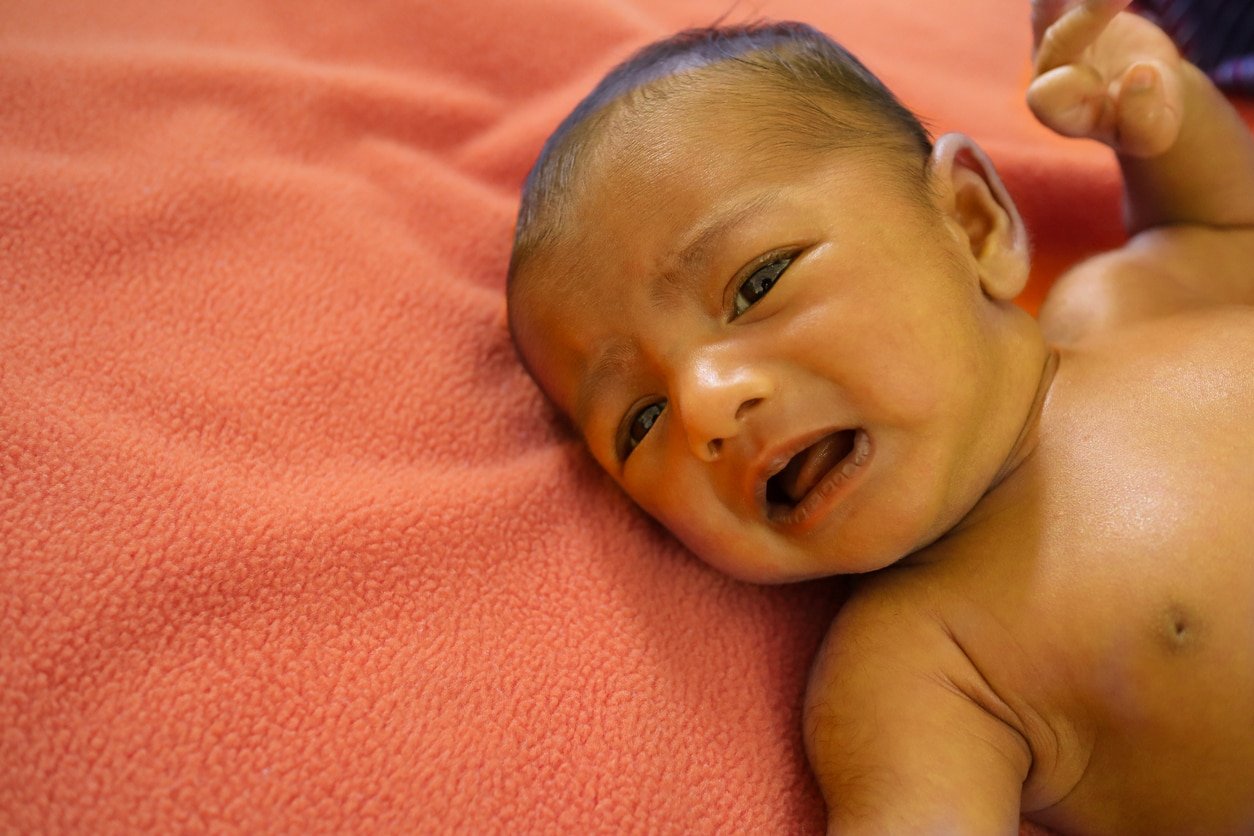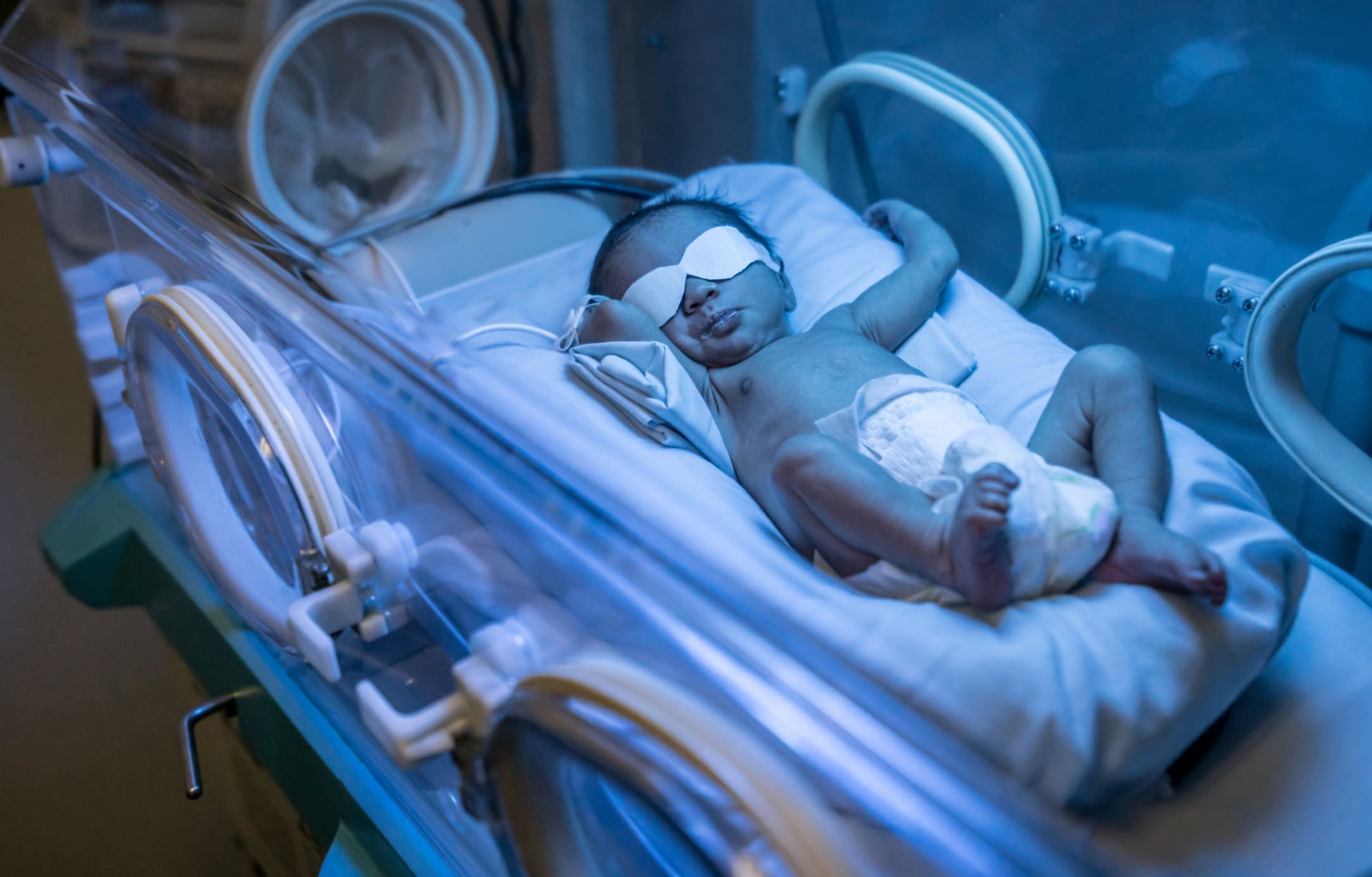When I was a NICU nurse, it seemed like every baby had a low level of jaundice. It became so common and second nature in my mind that it seemed like no big deal. Then, when my own daughter was born, she got pretty yellow pretty quickly and ended up needing treatment for high bilirubin. Even with my former NICU nurse experience, I had to brush up on my knowledge of jaundice in newborns. Jaundice can be confusing because the diagnosis and treatment can vary depending on severity and how old the baby is. Here, we’ll explain everything you need to know about jaundice in newborn babies, including types, causes, symptoms, neonatal jaundice therapies and treatment (including phototherapy), when to worry, and prevention.

Jaundice in newborns is a yellowing of the skin and sometimes even the whites of the eyes.1 Excess bilirubin in the blood causes the yellow color.2 Bilirubin is a natural byproduct of broken-down red blood cells. Usually, bilirubin is filtered out by the liver and excreted in the stool.3 If bilirubin isn’t filtered out of the blood quickly enough and builds up instead, this causes the baby’s yellow appearance.2
Most of the time, jaundice in newborns is normal, mild, and short-lived.4 However, if bilirubin levels in newborns climb very high and you don’t treat it, it can cause brain damage.1
Human bodies are constantly breaking down and replacing red blood cells. The byproducts of this breakdown cause jaundice if they build up. When you were pregnant, your placenta was responsible for filtering bilirubin from your baby’s blood to prevent buildup. Now that your baby has been born, their liver must take over removing the bilirubin. It can take some time for this organ to become efficient at removing bilirubin on its own.4
Bilirubin can be high because the liver isn’t removing normal levels of bilirubin quickly enough. In these cases, it will usually learn how to do so and catch up on its own, usually within the first week of life. Diseases, infections, medications, low oxygen, and other genetic disorders can contribute to a baby’s liver having difficulty removing bilirubin.4
Bilirubin can also be high because of an abnormal number of red blood cells being broken down. Blood or bleeding disorders can cause the extra breakdown of red blood cells. These include:4
- Sickle cell anemia
- Blood type incompatibility between mom and baby
- Bleeding or bruising under the scalp from a difficult delivery
- High red blood cell count in small babies or twins
- Some types of infections
The various causes of jaundice outlined above can cause different types of jaundice in newborns:
Most newborns experience some level of yellowing of the skin in the first few days of life.4 This is particularly common in preterm babies born before 38 weeks of gestation, but it can affect even full-term infants.3 A newborn’s immature liver may be unable to keep up with the amount of bilirubin produced, so it builds up, causing the yellow color.3 This is called physiological jaundice. It usually appears between days two to four of life and most often resolves on its own by 2 weeks of age.4
While physiological jaundice can happen to any baby in the first few days of life, it’s more common in breastfed babies. Suboptimal intake jaundice occurs in the first week of life and often happens when mom’s milk is slow to come in or when baby doesn’t eat well.4,5 When a new baby doesn’t get enough milk, they may become dehydrated and not void or stool enough. Since bilirubin is excreted in poop, if baby isn’t eating enough to move things through the intestines, it’s more likely to build up and cause jaundice.6
The benefits of breastfeeding outweigh the temporary issue of suboptimal intake jaundice. More frequent feedings can help resolve breastfeeding jaundice more quickly. Aim for eight to 12 feedings every 24 hours in the first few weeks.3 If you’re diagnosed with suboptimal intake jaundice and are breastfeeding, please talk to your pediatrician or a breastfeeding medicine provider about ways to optimize feeding your baby while increasing your chance of breastfeeding success.
Breast milk jaundice has a later onset than breastfeeding jaundice — it usually starts after seven days of life. It often peaks between weeks two and three of life but can last for a month or more. My first daughter had breast milk jaundice, and I remember her skin and eyes still looking yellow at her one-month appointment. A theory for the cause of breast milk jaundice is that components of the breast milk affect how the liver is able to break down bilirubin.4,5

Regardless of the type of jaundice a baby has, the symptoms can be similar. The primary symptom is a yellow appearance of the skin and eyes. The yellow color starts at the head and gradually moves down toward the feet. If you have trouble seeing a yellow color in your baby’s skin, you can gently press your finger to their forehead and observe the skin immediately when you lift your finger.7
Other symptoms that occur when jaundice has become dangerously high include poor feeding, low muscle tone, and lethargy.8 The problem with poor feeding being a symptom of jaundice is that not eating well makes jaundice worse!6 For me, it was difficult to differentiate normal newborn sleepiness from true lethargy. If you’re ever concerned about fatigue in your baby, be sure to ask your doctor about it.
While early signs of jaundice include lethargy and low tone, if you don’t treat it and it progresses, late signs of jaundice can be just the opposite — irritability and tight muscle tone. Other late signs of jaundice may include fever, apnea (stopping breathing), and brain symptoms such as seizures and arching backward.8 If jaundice continues to be left untreated, it can result in chronic and sometimes permanent effects called kernicterus, or neurological damage from bilirubin.9 This can include cerebral palsy and hearing loss.8 Only a very, very small percentage of babies go on to have this life-threatening jaundice. But it’s difficult to distinguish “normal” jaundice from that which will progress, so please talk to your doctor.
If you’re wondering when to worry about jaundice in babies, look for signs that your baby is looking or acting sick, isn’t feeding well, is extra sleepy, or has jaundice that appears to be worsening.7
Most hospitals check for jaundice before discharging you and your baby.7 There are different ways to diagnose jaundice:
The pediatric provider in the hospital will do a full body assessment on your baby and see whether they notice any yellowing of the skin or eyes. This is the first clue that your baby may have high bilirubin levels.7,10
This is the meaning of the acronym TcB.11 Some hospitals have a device that measures bilirubin through a probe on the skin. They may place it on baby’s forehead or chest. But depending on your location, they may or may not use TcB.10
Some newborn care settings jump straight to a blood draw looking at your baby’s bilirubin level.10 The hospital I delivered at routinely checks a serum (blood) bilirubin level at 24 hours of life. My postpartum nurse friend at another hospital reported that they check bilirubin levels at 24, 48, and 72 hours of life if the patient is still admitted. A blood test can be performed with a quick heel stick and is often collected with other newborn blood tests.11
The normal bilirubin level in a newborn depends on how many hours or days old they are. It’s expected that bilirubin levels rise in the first few days of life as the baby ages. Bilirubin often peaks around day four and then gradually declines.8 If your baby’s bilirubin is high or climbing quickly, their provider may recommend treatment for jaundice.
There are several possible newborn jaundice treatments, depending on the severity. If you’re wondering how to lower bilirubin, some neonatal jaundice therapies include phototherapy, frequent feed and supplementation, and, if the baby is dehydrated or the jaundice is severe, intravenous fluids. In rare cases, they may need a blood exchange transfusion. Let’s explore each of these treatments:
Typically, treatment for jaundice involves phototherapy. Phototherapy means putting baby under a blue light that helps break down bilirubin. Under the phototherapy lights, your baby will be naked, except for a diaper and an eye mask. This maximizes the amount of their skin exposed to the blue light.11
Sometimes, your baby may also lay on a bili blanket so their back gets blue light exposure as well.12 A baby’s temperature should be closely monitored while receiving phototherapy. Phototherapy can cause overheating because of the temperature of the lights, or baby can get cold because they’re naked and unswaddled.13
Here’s a photo of my daughter receiving phototherapy with blue lights and a bili blanket:

Bowel movements and adequate hydration can decrease bilirubin in your baby’s blood. Ensuring baby gets enough milk by providing them with eight to 12 feedings per day can sometimes be all the treatment they need for jaundice.11 If you’re breastfeeding and your milk supply hasn’t fully come in yet, some providers may recommend supplementing with formula or pumping for expressed breast milk to bottle feed to promote voiding and stooling.5
In more severe cases of jaundice, your baby may need a more immediate removal of bilirubin in their blood. In an exchange transfusion, some of your baby’s blood is replaced with donated blood to dilute the bilirubin.10,11
Some level of jaundice in newborns is normal, and you can’t always prevent it. However, the prevention strategies for jaundice are similar to the treatments:
Be sure your baby is getting enough feedings in both volume and frequency. Again, if you’re breastfeeding your baby, this means at least 10-12 feedings per day, at least until your milk comes in. If you’re formula-feeding, offer formula every two to three hours for their first week of life. Be sure that baby gets at least eight feedings per 24-hour day.11
In one study, when compared to no attempt at prevention, babies who were intentionally exposed to sunlight had reduced levels of jaundice and were jaundiced for shorter amounts of time.13 Of course, in the study, they used light-filtering films to protect babies from overheating, dehydration, and sunburn, which may not be practical for you at home! But a little passive sun exposure may help prevent jaundice, as long as you don’t place baby in direct sunlight for prolonged periods of time.
It can be scary if your baby has jaundice, but knowing the signs to look for if it’s worsening can help you be on alert. Fortunately, if caught early, jaundice is almost always mild and easily treated. Always reach out to your pediatrician if you’re concerned.

 PARENTING TIPS
PARENTING TIPS PREGNANCY
PREGNANCY BABY CARE
BABY CARE TODDLERS
TODDLERS TEENS
TEENS HEALTH CARE
HEALTH CARE ACTIVITIES & CRAFTS
ACTIVITIES & CRAFTS


